Bullet Basics 1- Caliber
When a bullet is submitted
for comparison to a firearm, one of the first examinations
conducted will be to determine the bullet's caliber.
Caliber is a
term used to indicate the diameter of a bullet in hundredths of an inch.
A bullet that is 30 hundredths of an inch (.30) in
diameter is called a 30 caliber bullet. The term caliber is of English origin and
is used by ammunition and firearm manufacturers in the United States. Firearms and
ammunition of European origin use the metric system and would refer to a 30 caliber bullet
as an 7.62mm bullet.
The caliber of the
bullet is just the first class characteristic that must agree with the
questioned firearm. The bullet must also be of the type found in cartridges
that the firearm will fire. A
cartridge is a single unit of ammunition consisting of the cartridge case, primer,
and propellant with or without one or more projectiles. The
image below shows these various components.
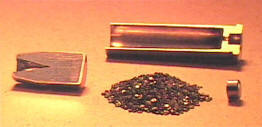
Cartridges are
usually given a name or cartridge designation by their developer,
who is more often than not the
manufacturer of a firearm (It doesn't make much sense to develop a
cartridge if you don't have a firearm to fire it in). The cartridge designation
typically includes a numerical value to indicate the
approximate diameter of the bullet and
will often include the manufacturer's name.
It never fails that
when a cartridge is developed the manufacturer or others will immediately try
to improve on the design. Variations to the original cartridge
are usually inevitable and may be in the form of a longer or shorter case,
differences in gunpowder, or differences with
the weight and type of bullet contained in the cartridge. For
more information on bullet characteristics click here for
Bullet Basics.
When a variation in
the cartridge case length occurs the cartridge's name may include the
term Short, Long, or Magnum to denote the difference. Examples
of which are the 32 S&W and the 32 S&W LONG cartridges seen
below. SMITH &
WESSON developed both of these cartridges for use in their 32 caliber revolvers.
As you can see, the 32 S&W Long cartridge on the right has the
longest cartridge case.
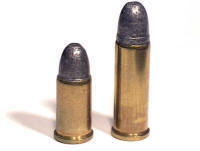
Long or magnum
cartridges may also have a heavier bullet when compared to the standard or short
versions. The 32 S&W
cartridge above contains an 88 grain bullet and the LONG version
contains a 98 grain bullet.
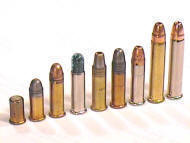 Other
variations can occur in the
bullet weight and bullet construction within the same cartridge designation.
All of the cartridges seen
on the right are in the 22 caliber "family" yet each has a different cartridge
designation. From the left they are: 22 Blank, 22 Short, 22 Long, 22 Long Rifle Shot, 22 Viper,
22 Long Rifle, 22 Stinger, 22 Magnum, and 22 Maximum. Other
variations can occur in the
bullet weight and bullet construction within the same cartridge designation.
All of the cartridges seen
on the right are in the 22 caliber "family" yet each has a different cartridge
designation. From the left they are: 22 Blank, 22 Short, 22 Long, 22 Long Rifle Shot, 22 Viper,
22 Long Rifle, 22 Stinger, 22 Magnum, and 22 Maximum.
Cartridges
designed for use in auto loading pistols will usually have the word AUTO
in their cartridge designation (i.e. 32 AUTO, 45 AUTO). Cartridges
can also carry a +P designation that stands for plus
power. Cartridges with the +P designation usually have no external differences
from the lower powered varieties but contain different types of gunpowder to achieve
higher velocities.
Measuring the bullet's diameter, weighing the bullet,
and examining the
physical characteristics of the bullet help firearm examiners to arrive
at a basic caliber for the submitted bullet. Firearm examiners
also can compare the questioned
bullet to known reference standards. Most firearms sections
maintain an ammunition reference collection and manufacturers catalogs
that can be used as reference material in determining a bullet's
caliber.
Sounds
simple doesn't it? Well.... not so fast!
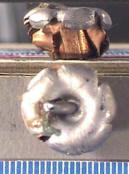
It's one
thing to look at the bullet above (looking
down on the bullet with a mirror in the back showing the bullet's profile)
and to say "that's a
Federal 9mm Hyda-Shok bullet,"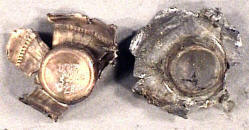 when more than likely
you've got a bullet from the victim like the one on the right.
Is the bullet from a 9mm LUGER,
a 38 SPECIAL, a 380 AUTO, or a 357 MAGNUM cartridge? You get the idea.
Sometimes firearm examiners can be very specific but there are times when we
just can't narrow things down to one particular caliber or cartridge. when more than likely
you've got a bullet from the victim like the one on the right.
Is the bullet from a 9mm LUGER,
a 38 SPECIAL, a 380 AUTO, or a 357 MAGNUM cartridge? You get the idea.
Sometimes firearm examiners can be very specific but there are times when we
just can't narrow things down to one particular caliber or cartridge.
To further confuse the issue, firearms are normally designed to fire a
specific type of cartridge. However, some firearms chambered to
fire one cartridge can also fire another. One of the most common
examples is that a revolver chambered for 357 MAGNUM cartridges can
also fire a 38 SPECIAL cartridge. However, a firearm chambered
for 38 SPECIAL cartridges cannot fire 357 MAGNUM cartridges.
This must be considered in examining the submitted bullet. You
don't want to automatically eliminate a bullet based on its caliber
until you determine the varieties that may be fired in the questioned
firearm.
If the caliber of the bullet
submitted for examination matches the caliber of the submitted firearm
or if we just aren't sure of the bullet's caliber, the firearm examiner will look for additional class characteristics in the form of
rifling to further narrow their search. Click
the Next button below to continue.
|